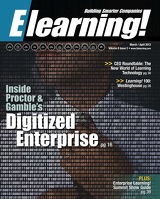Elearning! Magazine: Building Smarter Companies via Learning & Workplace Technologies.
Page 22 of 52
roadtoapositiveroi The R.O.I. Calculation
ROI=Net Base Program Benefits÷Program Costs Multiplied by 100
BUSINESS ALIGNMENT Business alignment is the process of ensur- ing that investment drives relevant busi- ness results. Achieving business alignment requires that programs, projects, and ini-
tiatives be positioned for success by: >>Clarifying stakeholder needs prior to >>investing in the program
Developing measurable objectives that represent the outcomes associated with >>stakeholder needs
Evaluating the success of e-learning at >>all levels, including the ROI
Using the chain of impact as the basis for data categorization, clear alignment between needs, program objectives, and evaluation exists.
DEFINE ACCEPTABLE An acceptable ROI for an e-learning ini- tiative may be one that is higher than the ROI for the same program delivered in a face-to-face format. However, it is not always feasible to run two programs at the same time using different delivery methods, then conducting an ROI study on both to make the comparison. Even
still, to know whether or not the ROI in the e-learning investment is a good return, there must be a target. If the ROI of the e-learning program falls below the target, the program was not successful in terms of financial contribution. If it meets the target, it was successful. If the pro- gram exceeds the hurdle rate, it was bet- ter than expected.
SETTING THE ROI TARGET
Techniques for setting sample targets: >>At the same level as other investments >>e.g. 15%
Slightly above other investments e.g. >>25%
>>At break-even, 0% Based upon client expectations By comparing ROI to an objective or an
alternative solution, you can define whether or not the ROI is acceptable. But the ROI is not going to explain how much job performance has improved or how much learning occurred or even how effective the e-learning solution is in terms of relevant content, ease of use and appropriateness. While the ROI is the ultimate measure
of e-learning success, it will not help you explain how you got to that ROI; and it certainly won't answer questions about how to improve the program in the future. For these reasons, additional measures of success are taken. The most logical and
most useful measures are represented in the chain of impact.
CHAIN OF IMPACT The real payoff of e-learning begins with how successfully participants apply what they learn back on the job (Level 3). Given that there are elements in the organizational universe that can get in the way of applica- tion, this level of measurement also requires that the capture of barriers and enablers to
Level 5 ROI, on the chain of impact, is the
ultimate meas- ure of success.
application. These data describe how well the organization system is supporting the transfer of learning. If the organization (e.g. supervisors, peers, processes or other func- tions) doesn't support the transfer of learn- ing, then application will not occur. If there is no application, there is no improvement in business measures (Level 4). Improvement in business measures of
output, quality, cost, time, customer satis- faction, employee satisfaction, work habits and innovation are the critical results that describe the impact e-learning has on the organization. Knowing that these measures can improve as a result of any number of causes, the chain of impact accounts for these other factors by isolating the effects of the e-learning program on the improve- ment in these measures. However, an improvement at Level 4 is
no guarantee there is a payoff for the e- learning solution. It is only when we bring in additional data and take addi- tional steps that the real payoff of e-learn- ing is known. Level 5, ROI, on the chain of impact is
the ultimate measure of success. This met- ric describes just how well the benefits of a program compare to the costs. By convert-
22 March / April 2012 Elearning!
